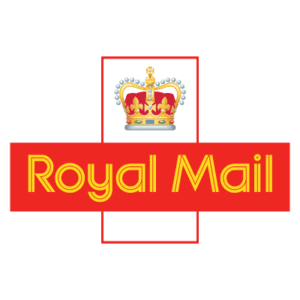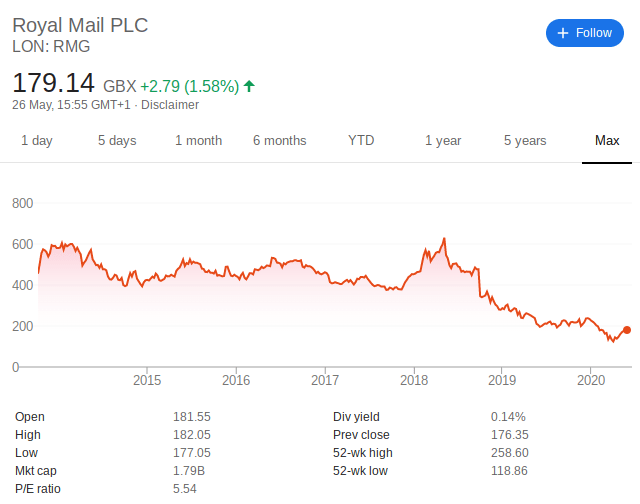How to Buy Royal Mail Shares UK
If you’re based in the UK and wish to invest in Royal Mail, you’ll need to find the UK share dealing site that gives you access to the London Stock Exchange, open an account, and deposit funds – and then decide how much you wish to invest in the stock. The shares will then be added to your portfolio in a matter of seconds.
In this guide, we show you the steps required to invest in Royal Mail shares. We also explore some of the popular UK stockbrokers to do this with.
Your first port of call will be to find a UK stock broker that meets your needs. There are hundreds of platforms that allow you to purchase Royal Mail shares, so it is important to review brokers based on the fees provides, tools available and other asset classes that allow you to diversify your trades. Below, we have listed three popular UK share dealing platforms that can help you in your investment process. For example, you will be able to apply leverage on your stock CFD trades of up to 1:5 (and more on other asset classes), meaning that a £200 balance would permit a £1,000 order on Royal Mail shares. You will also be able to choose from both buy/sell orders on Royal Mail stock CFDs at Plus500. This means that you will be speculating on whether the value of the stock CFDs will go up or down. Additionally, Plus500 offers much tighter spreads, as the underlying stock does not actually exist. You won’t need to pay any commissions either, so it’s only the spread that you need to take into account. If you are interested in a short-term trading strategy, Plus500 allows users to open an account in minutes, and make a minimum deposit of £100. In terms of safety, Plus500UK Ltd is authorized & regulated by the FCA (#509909). The broker’s parent company is also listed on the London Stock Exchange, so safety shouldn’t be a concern. 72% of retail investors lose money trading CFDs at this site To get the lower price, you will need to have bought or sold three stocks in the prior month. Even at £8 per trade, this is still really competitive. You will also benefit from a stock broker that has been in business for more than 46 years. Naturally, IG is heavily regulated, including a license with the FCA. If you are looking to create a diversified portfolio of shares, IG hosts thousands of companies. This includes both UK and international stocks. In terms of getting started, IG requires a minimum deposit of £250. Cash can be added to your account via a debit/credit card or bank account.
Your capital is at risk. Once you have done a bit of homework and decided which UK stock broker you wish to use, you will then need to open an account. This rarely takes more than a few minutes, and simply requires some personal information from you. If you’re yet to register at an online investment site, below you will find a handy step-by-step walkthrough. After you have chosen a suitable brokerage that meets your requirements, you can begin trading following the instructions below: Begin with providing your personal information. This may include: Usrs will also be asked to confirm their identity, as is the case when investing with FCA-regulated brokers. This is to prevent fraudulent account applications. The two documents that you will need to upload are: Your account should be verified in a couple of minutes. When it comes to supported payment methods, many brokerages offer the following supported options: Your deposit will be credited instantly – unless you transfer funds with a UK bank account. As soon as you have funded your newly created brokerage account, you may begin the investment process. The easiest way to get to the respective trading page is to enter ‘ROYAL MAIL’ into the search box at the top of the screen on your trading platform. You will then be presented with an order box, and need to enter the amount you wish to put into the trade to confirm the transaction. Those that managed to get a look in were rewarded within the first day of trading, with the stocks increasing to 455p. This represents an increase of 36% in less than 24 hours. Although the stocks then traded sideways for the following four years, Royal Mail hit all-time highs in 2018 at just over 631p per share. Had you invested during its IPO and sold at its peak, you would be looking at gains of over 90%. However, since its 2018 peak, Royal Mail has seen its shares move in the wrong direction. At the time of writing in mid-2020, the shares are trading at just 177p. This is about half of what the firm’s shares traded at during its 2013 IPO, which is somewhat concerning for investors. If you are looking to invest in the stock, here are a few features to know about Royal Mail before making your investment. The obvious starting point is that of its current share price range. At 177p, this represents a significant discount to what early investors paid during the 2013 IPO. Crucially, the UK postage network is controlled by Royal Mail, which is what makes it such a popular company. While the stock price is 50% lesser since its IPO release, users will want to make sure to conduct a proper analysis of the financials and data before opening a trade. There is no getting away from the fact that the number of traditional letters being posted – not just in the UK but globally, is on a steep decline. In full recognition of this, Royal Mail has since looked to innovate to increase its tightening margins. For example, the postage company is now part of a Click & Collect network that is available in over 10,000 UK post offices. The firm has also launched a Sunday service in conjunction with Parcelforce, which it hopes will give it the edge in the premium postage sector. Royal Mail has also dedicated resources to its IT network, with the view of streamlining some of its outdated processes. With its core letter business on the decline, management at Royal Mail is taking an aggressive approach to free up some much-needed capital. At the forefront of this is the announcement of 1,000 job cuts. It is believed that this will result in annual savings of over £50 million. Sentiment around Royal Mail shares is somewhat bearish at the moment – which is fully evident in its current stock price of 177p. The overarching concern for stockholders is that Royal Mail is operating in a declining industry – with digital alternatives being favoured over traditional letters. The firm is also heavily restricted in what it can charge for its core services – as per stringent UK government regulations. On the flip side, Royal Mail shares are available at a discounted rate. However, you should conduct your own research and decide on whether or not to invest in this asset for the future. Royal Mail was a publicly-owned company for over 500 years. Then, in 2013 the government decided to privatize the postage firm. When the stocks were listed on the London Stock Exchange for the first time in 2013, they were originally priced at 330p. By the end of the trading day, the stocks increased to 455p. Yes, Royal Mail is a dividend-paying company. However, there is no guarantee that this will always be the case – especially when you consider the firm’s aggressive cost-cutting strategy. This depends on the brokerage platform that you decide to use. Depending your brokerage, you can begin investing with $10. Most UK stock brokers allow you to purchase Royal Mail shares with a debit/credit card or bank account. Kane Pepi is a British researcher and writer that specializes in finance, financial crime, and blockchain technology. Now based in Malta, Kane writes for a number of platforms in the online domain. In particular, Kane is skilled at explaining complex financial subjects in a user-friendly manner. Academically, Kane holds a Bachelor’s Degree in Finance, a Master’s Degree in Financial Crime, and he is currently engaged in a Doctorate Degree researching the money laundering threats of the blockchain economy. Kane is also behind peer-reviewed publications - which includes an in-depth study into the relationship between money laundering and UK bookmakers. You will also find Kane’s material at websites such as MoneyCheck, the Motley Fool, InsideBitcoins, Blockonomi, Learnbonds, and the Malta Association of Compliance Officers. WARNING: The content on this site should not be considered investment advice and we are not authorised to provide investment advice. Nothing on this website is an endorsement or recommendation of a particular trading strategy or investment decision. The information on this website is general in nature, so you must consider the information in light of your objectives, financial situation and needs. Investing is speculative. When investing your capital is at risk. This site is not intended for use in jurisdictions in which the trading or investments described are prohibited and should only be used by such persons and in such ways as are legally permitted. Your investment may not qualify for investor protection in your country or state of residence, so please conduct your own due diligence or obtain advice where necessary. This website is free for you to use but we may receive a commission from the companies we feature on this site. Buyshares.co.uk provides top quality insights through financial educational guides and video tutorials on how to buy shares and invest in stocks. We compare the top providers along with in-depth insights on their product offerings too. We do not advise or recommend any provider but are here to allow our reader to make informed decisions and proceed at their own responsibility. Contracts for Difference (“CFDs”) are leveraged products and carry a significant risk of loss to your capital. Please ensure you fully understand the risks and seek independent advice. By continuing to use this website you agree to our privacy policy. Trading is risky and you might lose part, or all your capital invested. Information provided is for informational and educational purposes only and does not represent any type of financial advice and/or investment recommendation. Crypto promotions on this site do not comply with the UK Financial Promotions Regime and is not intended for UK consumers. BuyShares.co.uk © 2026 All Rights Reserved. UK Company No. 11705811.
Step 1: Review a UK Stock Broker
1. Plus500

2. IG

Step 2 : Open an Account.
Step 3: Purchase Royal Mail Shares
Overview of Royal Mail Shares

Features of Royal Mail
Shares Can be Purchased at a Discount
Innovation is Key
Cost-Cutting is Freeing-Up Capital
The Verdict
FAQs
When did Royal Mail become a PLC?
How much were Royal Mail shares originally?
Does Royal Mail pay dividends?
What is the minimum amount of Royal Mail shares I can purchase?
What payment methods can I use to purchase Royal Mail shares?
Kane Pepi

